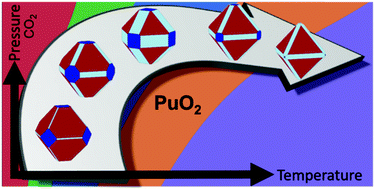The energetics of carbonated PuO2 surfaces affects nanoparticle morphology: a DFT+U study†
Abstract
Radiolytic corrosion of actinide materials represent an issue for the long term storage and disposal of nuclear materials. Molecular species adsorbed at the surface of the actinides may impact the rate of radiolysis, and as the surfaces corrode, the soluble toxic and radioactive species leach into groundwater. It is therefore critical to characterise the surface composition of actinides. Here, we employ ab initio modelling to determine the surface composition of PuO2 with respect to adsorbed CO2. We found that CO2 interacts strongly with the surface forming carbonate species. By mapping the energetics of this interaction, we then calculate the temperature of desorption, finding that surface morphology has a strong impact on the adsorption of CO2, with the {100} being the most and the {111} the least affected by carbonation. Finally, we predict the effect of carbonation on the morphology of PuO2 nanoparticles as a function of temperature and pressure, finding that truncated octahedral is the preferred morphology. This modelling strategy helps characterise surface compensition and nanoparticle morphology, and we discuss the implication for radiolytically driven dispersal of material into the environment.

- This article is part of the themed collection: 2020 PCCP HOT Articles


 Please wait while we load your content...
Please wait while we load your content...